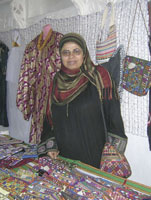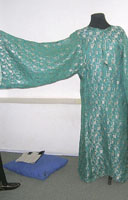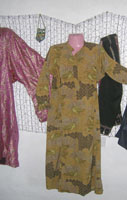
Reflecting on traditional fashion:Yemen as a creative country [Archives:2006/993/Reportage]
October 26 2006
 |
 |
 |
The gap between modern and traditional fashion designs has its own historical roots. Jahaf said, “With the Yemeni revolution of 1962 against the Imamate rule took place, people began to establish a new society. The circle of isolation was broken and as a result to poverty, ignorance, injustice and a series of deadly diseases that prevailed in the country, Yemenis were ready to overthrow everything that related to the Imam in order to change their lives. Even those traditional and heritage conscientious people, considered the remains of the Imam's influence should be ignored and forgotten.
Many materials were imported and consequently home-grown handcrafters became jobless. These immigrated to various Gulf countries to find other jobs hoping to improve their outcomes. At the beginning of nineties, Yemenis and several neighboring countries were interested in the re-flourishing of heritage; however, I don't know the real reason beyond this. Even the companies of more worldly acclaimed fashion designing were inspired in their modern designs with those of eras past. Even though this spoke of a flowering trend, wearing these old designs only emerged upon occasion.”
Yemeni women have historically received a new dress yearly for those special occasions or ceremonies such as Eid and wedding parties. The art of constructing clothes from patterns goes back much further.The old design patterns which predominated for centuries, however, are a far cry from the newer ones. The older designs depended on geographical environment of a given city and the raw materials available in each region. Now most of the fashion designs have a non-Yemeni identity where most have been imported. “In the past all the whole process of producing clothes; from harvesting and cleaning the fiber or wool to designing, cutting and sewing the cloth into clothes, took place in Yemen. And that clearly reflected the economic condition of Yemen”, says Amat Al-Razzaq Jahaf, the head of the Woman Development Center for Traditional Heritage.
The traditional design pattern
Materials: Cotton, flax, wool and silk, are the natural raw materials that are commonly used.
Features: The natural environment in its diversity of plains, mountains, hills and deserts make for variations on how people wear clothing and the quality of the woven fabric and the patterns of the embroidery.
In Heights
1. The quality and the fineness of the woven fabric are vital.
2. Textiles mostly used are cotton, flex, and wool; silks and other textiles are imported from India.
3. Women's clothes cover all parts of the body with a neckline that can be fastened with buttons. The sleeves are wide as well as long reaching, in many cases, the knees. The sleeves end with cuffs that can be fastened with links.
The Plains
1. Softness and lightness of the woven fabric is important.
2. Textiles mostly used are cotton and flax.
3. The women's dress has a wide neckline, usually in a rectangular or fourfold shape.
The Hills
1. Textiles used are silk, cotton and imported velvets.
2. Kodma and Thail (Front and Tail) is a style where the dress is short in the front and long in the back.
Artistic Features
Yemeni dresses are unique in their patterns and embroidery. They are smartly stylish as well as modest. Threads commonly used in sewing the cloth are of gold, silver, silk or cotton. The embroidery patterns are inspired from nature, shaped as plants or geometrical motifs.
Types of clothes:
Women normally wore two pieces of clothes; Qamees -a loose robe was worn over a dress. Qamees were usually worn when leaving the house, while the dress was worn for special occasions such as 'Eid, or in their daily lives.
1. Qamees
In Sana'a, the Qamees was usually made of Jerz or black velvet with a narrow neckline with the top of the sleeve that is wide until its lower segment that reaches the women's knees.
In Taiz, the Qamees is tight at the top; similar to older French designs. The sleeve is cut narrow from the top and widens until it reaches its lower part in a bell-bottoms design. Normally, we can easily see stitches in both sides against the fabric, but usually stitches in the front turned triangular shape.
In Sa'da, the most popular Qamees is called Aqeeda that is similar to Sana'ani version in terms of its design, but Aqeeda is stitched as a whole with the embroidery containing old coins, shells and buttons. The sleeve's lower end has a triangular shape. Such Qamees existed also in Al-Jawf and Marib.
2. Dress
In Shabwa, Hadhramout and Al-Mahara women wore a popular dress called Thail and Kodma (Tail and Front) where the tail back end is longer than the front. The length and shortness of the dress depended on custom. For example in Shabwa, the length of the tail was longer (10 cm) than the front. In Hadhramout, the length of the tail is longer (1 meter) than the front; and in Al-Mahara the tail is even longer (2 or 3 meters) than the front. In Shabwa the front is above the heels, in Hadhramout and Al-Mahara, the front is under the knees exactly. The tail, for the woman in Al-Mahara, is firmly secured to her waist with a silver belt.
Jahaf has stated the designs of such dresses are too old. One of the past's poets, Imro'o Al-Qais, one of the most famous poets on the Arabian Peninsula, mentions this kind of dress in one of his poems. (A Yemeni from Hadhramout, he was born in Najd in 105 CE).”One of the reason for making the tails long was due to traditions; another was to hide a woman's footprints,” Jahaf added.
In Tihma, one of the hotter cities, women wore a brassiere like shirt and a skirt made of light fabrics. Jahaf had to say about such designs, “This particular type of design is extremely different from others and rarely found anywhere else in Yemen. According to my studies and investigations, such designs have an Indian influence, similar to the Sari that consists of a blouse and petticoat.”
Arabian styled dresses are the most popular dress form in Sana'a. “Though it was worn only in Sana'a and several locations, I don't know why they call it Arabian”, Jahaf commented. It's designed in two pieces cut in semi circles, then stitched midway from the sleeve to the waist. This piece is then joined with the skirt piece through pleats.
——
[archive-e:993-v:14-y:2006-d:2006-10-26-p:report]


